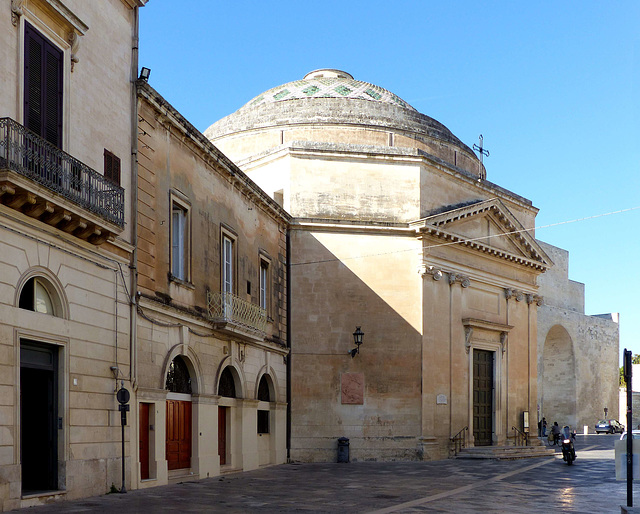Lecce - Amphitheatre
Lecce - Chiesa del Gesù
Lecce - Chiesa del Gesù
Lecce - Sant'Irene
Lecce - Sant'Irene
Lecce - Santa Maria della Grazia
Lecce - Duomo di Lecce
Lecce - Duomo di Lecce
Lecce - Palazzo dei Celestini
Lecce - Basilica di Santa Croce
Lecce - Basilica di Santa Croce
Lecce - Basilica di Santa Croce
Torre dell'Orso - Adriatic Sea
Torre dell'Orso - Adriatic Sea
Torre dell'Orso - Hotel Belvedere Salento
Torre dell'Orso - Hotel Belvedere Salento
Otranto
Otranto - PharmaShop24
Otranto - Castello Aragonese
Otranto - Harbour
Otranto - Basilica bizantina di San Pietro
Otranto - Cattedrale di Otranto
Otranto - Cattedrale di Otranto
Lecce - Porta Napoli
Lecce - San Niccolò dei Greci
Brindisi - Trattoria La Cucina
Brindisi - Piazza Mercato
Brindisi - Castello alfonsino
Brindisi - Via Appia
Brindisi - Via Appia
Brindisi - Museo Archeologico Ribezzo
Brindisi - Museo Archeologico Ribezzo
Brindisi - Cattedrale di Brindisi
Brindisi - Cattedrale di Brindisi
Brindisi - Cattedrale di Brindisi
Brindisi - San Giovanni al Sepolcro
Brindisi - San Giovanni al Sepolcro
Brindisi - San Giovanni al Sepolcro
Brindisi - San Giovanni al Sepolcro
Brindisi - San Giovanni al Sepolcro
Brindisi - San Giovanni al Sepolcro
Brindisi - San Giovanni al Sepolcro
Brindisi - San Giovanni al Sepolcro
Brindisi - San Giovanni al Sepolcro
Brindisi - San Giovanni al Sepolcro
Location
See also...
Keywords
Authorizations, license
-
Visible by: Everyone -
All rights reserved
-
83 visits
Lecce - Santa Maria della Porta


A legend tells, that a city called Sybar existed at the time of the Trojan War. It was conquered by the Romans in the 3rd century BC, receiving the new name of Lupiae.
After the fall of the Western Roman Empire, Lecce was sacked by the Ostrogoth troops of king Totila. In 549 it was taken by Byzantium and remained part of the Eastern Roman Empire for five centuries, interrupted by brief invasions by the Saracens, Longobards, Hungarians and Slavs.
After the Norman conquest in the 11th century, Lecce regained commercial and political importance, flourishing in the subsequent Hohenstaufen and Angevine rule. From the 15th century, Lecce was one of the most important cities of southern Italy, and, starting in 1630, it developed into a centre of Baroque architecture. This was made possible by the soft tuff stone found in the area, perfect for that architecture.
-
Santa Maria della Porta is a round church, adjacent to the Porta Napoli. Originally there was a chapel outside the city walls, containing an image of the Virgin, which was considered miraculous. Work had begun to renew the city walls in 1548, but on account of a renowned miracle, worked by the image on a woman named Laura Macchia, who could walk after being paralyzed for 50 years, the structure was enlarged and built inside the walls.
The present, octagonal building was rebuilt in Neo-classical style 1852 - 1858.
After the fall of the Western Roman Empire, Lecce was sacked by the Ostrogoth troops of king Totila. In 549 it was taken by Byzantium and remained part of the Eastern Roman Empire for five centuries, interrupted by brief invasions by the Saracens, Longobards, Hungarians and Slavs.
After the Norman conquest in the 11th century, Lecce regained commercial and political importance, flourishing in the subsequent Hohenstaufen and Angevine rule. From the 15th century, Lecce was one of the most important cities of southern Italy, and, starting in 1630, it developed into a centre of Baroque architecture. This was made possible by the soft tuff stone found in the area, perfect for that architecture.
-
Santa Maria della Porta is a round church, adjacent to the Porta Napoli. Originally there was a chapel outside the city walls, containing an image of the Virgin, which was considered miraculous. Work had begun to renew the city walls in 1548, but on account of a renowned miracle, worked by the image on a woman named Laura Macchia, who could walk after being paralyzed for 50 years, the structure was enlarged and built inside the walls.
The present, octagonal building was rebuilt in Neo-classical style 1852 - 1858.
Ernest CH, Alexander Prolygin have particularly liked this photo
- Keyboard shortcuts:
Jump to top
RSS feed- Latest comments - Subscribe to the comment feeds of this photo
- ipernity © 2007-2024
- Help & Contact
|
Club news
|
About ipernity
|
History |
ipernity Club & Prices |
Guide of good conduct
Donate | Group guidelines | Privacy policy | Terms of use | Statutes | In memoria -
Facebook
Twitter

Sign-in to write a comment.